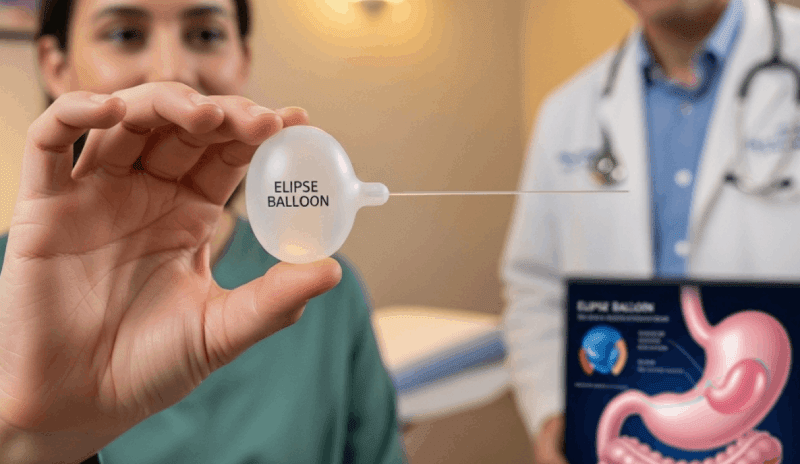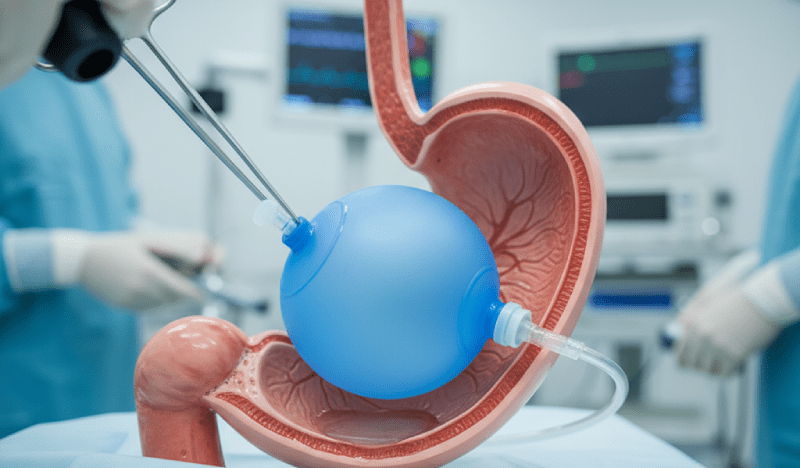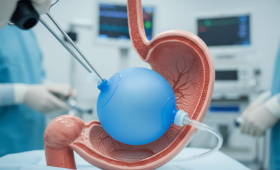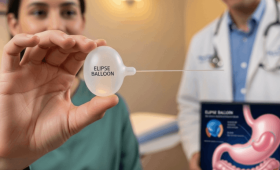What is a Gastric Balloon?
A gastric balloon is a non-surgical, temporary method used in the treatment of obesity. Its main purpose is to reduce the volume of the stomach, creating a feeling of fullness with less food, and thereby enabling weight loss. During the procedure, a silicone balloon is placed into the stomach with the help of an endoscope or by swallowing, and then inflated with a sterile liquid (usually saline) or air. This balloon creates a feeling of fullness in the stomach, physically limiting food intake. It remains in the stomach for an average of 6 to 12 months and is then removed, either endoscopically or naturally.
Who is a Suitable Candidate for a Gastric Balloon?
The gastric balloon procedure is an ideal option for individuals who are not suitable for or do not want to undergo surgery. Suitable candidates are individuals over the age of 18 with a Body Mass Index (BMI) between 25 and 40 who have serious health problems related to obesity or want to prevent these issues. It is also important that they have not had prior stomach or intestinal surgery and do not have an active stomach or esophageal disease. The gastric balloon should be seen as a starting tool for healthy lifestyle changes rather than a permanent solution.
Types of Gastric Balloons
There are different types of gastric balloons. The most common are those placed endoscopically. After these balloons are placed in the stomach, they are filled with blue-colored saline. Another type is the swallowable balloon. These balloons are swallowed like a pill, without the need for anesthesia, and then inflated with the help of a catheter. After remaining in the stomach for a certain period, they are naturally expelled from the body. The biggest advantage of swallowable balloons is that they do not require endoscopy or anesthesia for either placement or removal.
Preparation Before the Procedure
Before the gastric balloon procedure, you should have a comprehensive consultation with your doctor and have your health history evaluated. You may be asked to start a liquid-based diet plan a few days before the procedure. This helps to clean the stomach and reduce possible side effects during the procedure. It is also important to use the medications your doctor recommends regularly and not to eat or drink anything during the 6−12 hour period before the procedure. These preparations ensure that the procedure is completed safely and successfully.
Gastric Balloon Placement Procedure
The gastric balloon placement procedure is very fast and is usually completed within 20−30 minutes. During the procedure, the patient is under light sedation (a drowsy state), so they do not feel any discomfort. For endoscopic balloons, a thin tube with a deflated balloon at its tip is advanced through the mouth into the stomach. For swallowable balloons, the patient is asked to swallow the balloon with some water.
What Happens During the Procedure?
During the endoscopic procedure, the doctor uses a flexible tube called an endoscope to examine the stomach. The balloon is placed in the stomach with the guide wire at the tip of the endoscope, and after ensuring it is in the correct position, it is inflated with saline or air through a valve inside the balloon. The balloon is inflated to occupy space in the upper part of the stomach, and after this process is complete, the endoscope and guide wire are removed. The patient is discharged after being kept under observation for a few hours. Swallowable balloons, on the other hand, are checked with an X-ray after being swallowed and are inflated via a catheter.
How Does the Balloon Work in the Stomach?
The balloon placed in the stomach creates a continuous feeling of fullness due to its size. This fullness sends signals to the brain’s satiety center, causing the person to eat less. At the same time, it slows down the passage of food from the stomach to the intestines, extending the feeling of fullness. The physical presence of the balloon facilitates portion control and encourages the person to be satisfied with smaller meals. This mechanism provides significant support for creating a diet and healthy eating habits.

Contribution of the Gastric Balloon to Weight Loss
The gastric balloon is not a weight loss method on its own; however, it serves as an important tool in the weight loss process. The physical restriction provided by the balloon makes it easier for the individual to consume fewer calories. This, especially at the beginning, accelerates the weight loss process and provides motivation to the person. The gastric balloon, as a tool for discipline, allows the patient to acquire new and healthy eating habits under the supervision of a dietitian and doctor. Success depends largely on how well the patient adapts to these new habits.
Expected Weight Loss Rate
The expected weight loss with a gastric balloon varies from person to person and depends on factors such as age, gender, starting weight, and adaptation to lifestyle changes. In general, patients are expected to lose 10% to 15% of their total body weight. In some cases, this rate may be higher, but this is more related to the patient’s strict adherence to the diet and exercise program. It should be remembered that maintaining this weight after the balloon is removed is the real challenging and important stage.
Advantages of the Gastric Balloon
The gastric balloon has many advantages in the treatment of obesity. Its biggest advantage is that it is not a surgical procedure. This means there are no anesthesia risks and no post-operative recovery period. The reversibility of the procedure is also a significant plus; that is, the balloon can be removed at any time or in case of possible complications. In addition, the gastric balloon is a relatively low-cost option and is less invasive compared to other surgical methods. This method offers a strong source of motivation to start the weight loss journey.
Disadvantages of the Gastric Balloon
The gastric balloon also has some disadvantages. First, side effects such as nausea, cramps, and abdominal pain are common after the procedure. These symptoms usually subside within a few days, but may last longer in some patients. Secondly, the gastric balloon is not a permanent solution; after the balloon is removed, the patient’s return to old habits can lead to regaining the lost weight. Therefore, the opportunity provided by the balloon must be used wisely.
Possible Side Effects and Complications
Although the gastric balloon procedure is generally safe, some side effects and, rarely, complications can occur. Nausea, vomiting, and cramps are the most common complaints in the first few days. These complaints can be controlled with medications recommended by the doctor. Rare complications include the balloon deflating, gastric ulcers, or perforation. In the event of the balloon deflating, the blue liquid it contains changes the color of the urine to alert the patient, and the balloon must be removed endoscopically.
What Happens After the Balloon is Removed?
The removal of the balloon from the stomach is done endoscopically, similar to the placement procedure. The balloon is deflated by emptying the fluid inside and is then taken out through the mouth. This procedure is also performed under sedation. The removal of the balloon does not mean the end of the weight loss process; on the contrary, this stage is a critical turning point for making the acquired healthy eating and lifestyle habits permanent. Under the guidance of your dietitian and doctor, a transition plan to a life without the balloon should be prepared.
Diet and Nutrition Plan
Diet and nutrition are of vital importance for successful weight loss with a gastric balloon. In the first few days after the procedure, the patient starts with liquid foods, then moves on to pureed and soft foods. After about two weeks, a gradual transition to solid foods is made. Portions should be reduced, and small, frequent meals should be preferred. Sugary, fatty, and processed foods should be avoided. Drinking plenty of water is very important for the regular functioning of the digestive system and for maintaining a feeling of fullness.
Gastric Balloon and Exercise
The gastric balloon is not enough on its own. Regular exercise is essential for successful weight loss and weight maintenance. It is important to rest for the first few days after the gastric balloon is placed. Afterward, you can start with light walks and increase the intensity of exercise as your fitness improves. Aerobic exercises accelerate fat burning, while resistance exercises help to maintain muscle mass and speed up the metabolism. Exercise also improves mood and increases motivation.
Lifestyle Changes After Gastric Balloon
The biggest benefit of the gastric balloon is that it offers the individual an opportunity to adopt healthy lifestyle habits. This is not just a short-term diet, but a permanent lifestyle change. Setting regular meal times, controlling portions, staying away from alcohol and carbonated drinks, getting enough sleep, and managing stress are the cornerstones of these changes.

Psychological Effects of the Gastric Balloon
The weight loss process is a psychological process as much as a physical one. The gastric balloon can increase an individual’s self-confidence and be a positive source of motivation during this process. However, some patients may find it difficult to adapt to the restrictions caused by the balloon. Therefore, seeking psychological support before and after the balloon procedure can be beneficial for understanding and managing emotional eating habits.
Increasing Long-Term Success
Maintaining weight after the gastric balloon is removed depends on the continuation of the efforts made during the period the balloon was in place. The most important factor for long-term success is to maintain newly acquired eating habits and make regular exercise a part of life. Support from a dietitian and psychologist can help overcome the challenges that may be faced during this process.
Who is Not Suitable for a Gastric Balloon?
The gastric balloon is not a suitable treatment method in some cases. Those who have had prior stomach or intestinal surgery, those with serious stomach or esophageal diseases (ulcers, reflux, hiatus hernia, etc.), pregnant women or those planning to become pregnant, those with alcohol or substance addiction, and those with severe psychological disorders are not suitable candidates for this method.
Gastric Balloon vs. Surgical Methods
Compared to surgical methods (such as sleeve gastrectomy, gastric bypass), the gastric balloon is less invasive, has a lower risk, and is more affordable. However, surgical methods generally provide more and more permanent weight loss. Surgical methods may be more suitable for patients with a very high BMI, while the gastric balloon is ideal for individuals with a lower BMI or those who do not consider surgery as an option.
Risk of the Balloon Rupturing or Deflating
Modern gastric balloons are made of highly durable materials, and the risk of them rupturing is very low. However, there is a possibility that the balloon may deflate. Gastric balloons generally contain blue dye to alert the patient in case of deflation. If the balloon deflates and moves into the intestines, it can cause an intestinal blockage, which requires emergency medical intervention. Therefore, if signs of deflation (blue urine) are noticed, a doctor should be consulted immediately.
Gastric Balloon Price and Cost
The cost of a gastric balloon varies depending on the type of balloon used, the clinic where the procedure is performed, and the country. Although it is more affordable compared to surgical methods, these prices usually include services such as balloon placement, removal, and dietitian support. The most accurate approach for price information is to contact the relevant clinics and doctors directly.
Frequently Asked Questions About the Gastric Balloon
- How much weight can I lose with a gastric balloon? On average, you can lose 10-15% of your total body weight.
- Is the procedure painful? No, you will not feel any pain as it is performed under sedation.
- How long does the balloon stay in the body? Generally between 6 and 12 months.
- When can I return to my normal life after the balloon? Most people can return to their normal activities within a few days.
Success Stories and Realistic Expectations
Success stories show how effective a gastric balloon can be as a tool in the weight loss journey. However, every individual’s story is different. Realistic expectations involve understanding that the balloon is not a miracle, but it can give great results when supported by the right lifestyle changes.
Conclusion: Is the Gastric Balloon a Tool for Weight Loss?
The gastric balloon is a non-surgical and reversible tool that facilitates weight loss. It is not a standalone solution but a step that supports lifestyle changes such as healthy eating and regular exercise. Permanent success depends not only on the physical restriction provided by the balloon but also on the individual’s mental and behavioral adoption of new habits.



